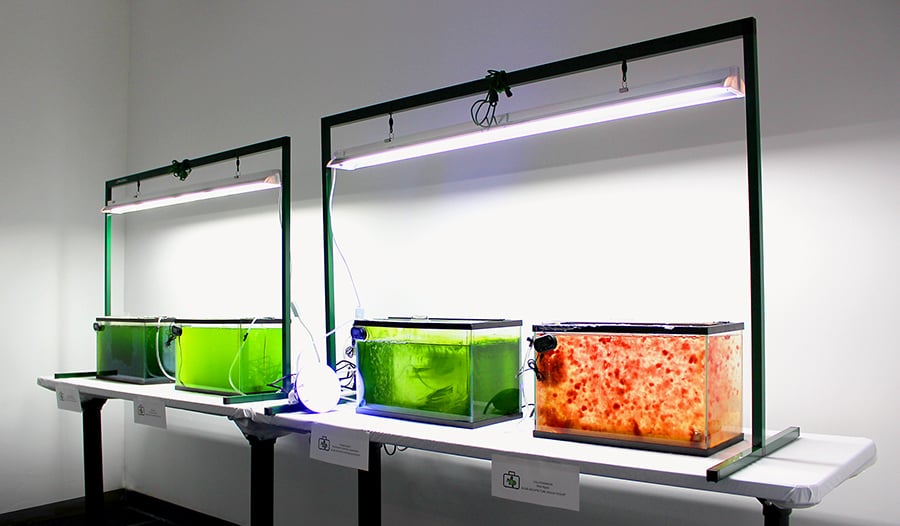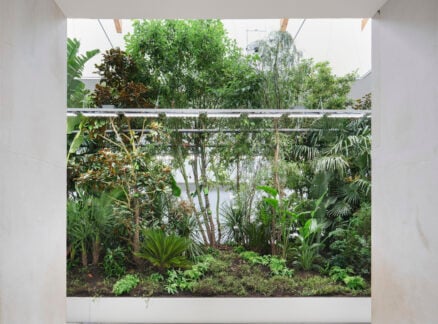
October 8, 2018
Researchers and Designers Are Totally Reinventing the Building Facade
From algae walls to circadian rhythm–savvy films and thermally-activated bimetal shades, a dramatic range of technologies could change the architectural envelope.

In a small, locked basement room in Newark, three tanks gurgle gently all in a row. Martina Decker, an associate professor and director of the Material Dynamics Lab at the New Jersey Institute of Technology, finds the right key on her chain and opens the door, releasing a slight organic smell, like the bulk beans-and-grains section of a grocery store. Up close, the vats bubble with mystery liquids—actually strains of cyanobacteria—each one a different shade of green, ranging from a young Japanese tea to pond scum in full bloom.
“These have a 14-day growth cycle; you can see it left to right,” says Decker, who is part architect herself, clad in black instead of a lab coat. “But even after four days, it’s pretty dark.”
Blue-green algae like spirulina—that muck brewing in Decker’s tanks—could provide food and even biofuel to power buildings in our planet’s resource-strapped future. In 2013, Austrian firm Splitterwerk and Arup tested out such a thesis for the International Building Exhibition in Hamburg, and suggested that incorporating micro-algae into a building envelope could increase the structure’s efficiency while also contributing to its inhabitants’ well-being.
In this vein, both researchers and design firms have continued to reconceptualize the facade, right down to its material composition. In addition to algae, these prototypes make use of “smart materials” that respond to changes in temperature, light, electric currents, or magnetic fields independently, without an external power source or mechanical system.

At the University of Southern California, a different experiment is under way. There, Doris Sung, an USC associate professor and cofounder of DOSU Studio Architecture, has developed a temperature-regulating double-glazed facade system with “thermal bimetal” inside the window cavity. More commonly known as the primary material of thermostat coils, bimetal comprises two thin sheets fused together, with one layer containing some nickel, manganese, and copper, and the other layer, nickel and iron. When the temperature rises, one side naturally expands a lot more than the other, causing the bimetal to curl. “They flip like little butterflies inside the window,” she says of the cutouts. “They’re a moving, active system.”
The effect is that the system reflects and refracts natural light just as easily as it blocks it out, allowing sunlight to penetrate deeper into rooms. The outcome was unexpected, admits Sung, who originally developed the prototype to control thermal gain.
Diffused daylight is the holy grail of facade functionality in workplaces, according to Jennifer Brons, an architecture-trained scientist at Rensselaer Polytechnic Institute’s Lighting Research Center in Troy, New York. Brons studies the way daylighting affects human circadian rhythms, often asking her research subjects to wear specially designed meters on lanyards around their necks so she can measure how much light, both daylight and electrical, hits them throughout a day. She says big doses of bright light, especially in the morning hours, are particularly good for stimulating a person’s circadian system, to the extent that she has even seen Alzheimer’s patients become less restless overnight once they’ve been exposed to more of it.

Brons and her colleagues have experimented with precise, custom-designed skylights called “lightscoops” that draw in a steady stream of diffused daylight. Already, she says, referring to a slew of facade innovations, there exist microscopic window films that bounce daylight “through the envelope and up to the ceiling.” (But because these tend to block views, “they may be more appropriate for upper clerestory windows,” she clarifies.) Then there are techniques like wrapping buildings in transparent meshes, grilles, fabrics, and adjustable screens. Yet years of experiments with materials such as these have made Brons increasingly pragmatic. “Passive, nonmoving solutions make more sense to me,” she says. “Anything that moves is going to break.”
But perhaps not micro-algae, as Decker has found. She is skeptical of the idea, and her studies question what living in close proximity to algae might do to humans—how the light coming through green walls would affect well-being, and sleep cycles in particular. After all, “algae walls might make you sleepy.”
It’s an overcorrection, and something Marilyne Andersen, professor and head of the Laboratory of Integrated Performance in Design at the École Polytechnique Fédérale de Lausanne in Switzerland, would rather avoid. Andersen studies human reactions to lighting in the built environment and even cofounded a consulting firm, Oculight Dynamics, to advise architects, engineers, and building owners on how best to deploy daylight in workspaces for well-being and productivity. This input might entail “adjusting or rethinking a facade,” she notes, but it should ideally accompany the design process itself.
She’s been using virtual reality headsets in recent studies, discovering that subjects respond most favorably to light patterns with more irregular, organic shapes, not unlike Sung’s “butterflies.” These patterns, she suggests, play a role in shaping a person’s perception of space and in determining the comfort level they come to associate with it. Andersen likes to joke that the venetian blind is still the solution to beat, but she urges designers to keep working on systems that use smart materials and new technologies to find precise ways to pull natural light deep into rooms.
“What I think is the most elegant is a facade that doesn’t move, but reacts to changing conditions outside, summer or winter,” says Andersen. “It’s a more interesting challenge.”
You may also enjoy “AHMM Transforms the University of Amsterdam With a Dramatic Canal-Framing Feat of Engineering.”
Recent Viewpoints
Viewpoints
Sustainability News Updates for Q2 2025





